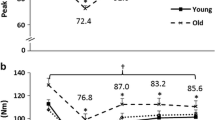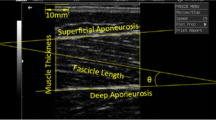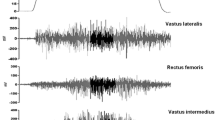Abstract
The current investigation was designed (1) to examine the effect of a 48-week strength training on musculotendinous (MT) and musculoarticular (MA) stiffness characteristics in older men and women; and (2) to evaluate the influence of gender on stiffness behaviour in response to such training. The training was performed twice per week and mainly consisted of three series of 10 repetitions of calf-rise at 75% of the 3-repetition maximum. Two methods were used to perform stiffness measurements during plantar flexion: (1) the use of quick-release movements, allowing the calculation of MT stiffness; (2) the application of sinusoidal perturbations to the joint, allowing the calculation of MA stiffness. In each case, stiffness was linearly related to torque, leading to the calculation of a normalized stiffness index (SI) as the slope of this stiffness-torque relationship: SIMT and SIMA, respectively. Results showed a similar decrease in SIMT among older men (−27%, P < 0.05) and women (−29%, P < 0.05) following training. A decrease in SIMA was only observed among women (−11%, P < 0.05). The results suggest that (1) MT stiffness decreases following training in older individuals, counterbalancing the effect of ageing; and (2) older men and women respond differently to the same resistance-training stimulus in terms of MA stiffness. Gender-related differences in MA stiffness response may originate from passive MA elastic structures.

Similar content being viewed by others
References
Agarwal GC, Gottlieb GL (1977) Oscillation of the human ankle joint in response to applied sinusoidal torque on the foot. J Physiol 268:151–76
Blanpied P, Smidt GL (1993) The difference in stiffness of the active plantar flexors between young and elderly human females. J Gerontol 48:58–63
Brown AB, McCartney N, Sale DG (1990) Positive adaptations to weight-lifting training in the elderly. J Appl Physiol 69:1725–1733
Cornu C, Goubel F, Fardeau M (2001) Muscle and joint elastic properties during elbow flexion in Duchenne muscular dystrophy. J Physiol (Lond) 533:605–616
Cresswell AG, Loscher WN, Thorstensson A (1995) Influence of gastrocnemius muscle length on triceps surae torque development and electromyographic activity in man. Exp Brain Res 105:283–290
Ferri A, Scaglioni G, Pousson M, Capodaglio P, Van Hoecke J, Narici MV (2003) Strength and power changes of the human plantar flexors and knee extensors in response to resistance training in old age. Acta Physiol Scand 177:69–78
Frontera WR, Meredith CN, O’Reilly KP, Knuttgen HG, Evans WJ (1988) Strength conditioning in older men: skeletal muscle hypertrophy and improved function. J Appl Physiol 64:1038–1044
Frontera WR, Hughes VA, Krivickas LS, Kim SK, Foldvari M, Roubenoff R (2003) Strength training in older women: early and late changes in whole muscle and single cells Muscle Nerve 28:601–608
Goubel F, Pertuzon E (1973) Evaluation de l’élasticité du muscle in situ par une méthode de quick-release Arch Int Physiol Biochim Biophys 81:697–707
Häkkinen K, Kallinen M, Izquierdo M, Jokelainen K, Lassila H, Malkia E, Kraemer WJ, Newton RU, Alen M (1998) Changes in agonist-antagonist EMG, muscle CSA, and force during strength training in middle-aged and older people. J Appl Physiol 84:1341–1349
Hill AV (1950) The series elastic component of muscle Proc R Soc Lond B Biol Sci 137: 273–280
Huxley AF, Simmons RM (1971) Mechanical properties of the cross-bridges of frog striated muscle. J Physiol (Lond) 218:59–60
Kearney RE, Hunter IW (1990) System identification of human joint dynamics. Crit Rev Biomed Eng 18:55–87
Kubo K, Kanehisa H, Miyatani M, Tachi M, Fukunaga T (2003) Effect of low-load resistance training on the tendon properties in middle-aged and elderly women. Acta Physiol Scand 178:25–32
Lakie M, Caplan N, Loram ID (2003) Human balancing of an inverted pendulum with a compliant linkage: neural control by anticipatory intermittent bias. J Physiol (Lond) 551:357–370
Lambertz D, Perot C, Kaspranski R, Goubel F (2001) Effects of long-term spaceflight on mechanical properties of muscles in humans. J Appl Physiol 90:179–188
Lambertz D, Mora I, Grosset JF, Perot C (2003) An evaluation of musculo-tendinous stiffness in prepubertal children and adults, taking into account muscle activity. J Appl Physiol 95:64–72
Lexell J, Downham DY, Larsson Y, Bruhn E, Morsing B (1995) Heavy-resistance training in older Scandinavian men and women: short- and long-term effects on arm and leg muscles. Scand J Med Sci Sports 5:329–341
Levy EC (1959) Complex curve fitting. IEEE Trans Autom Control 4:37–43
McCartney N, Hicks AL, Martin J, Webber CE (1996) A longitudinal trial of weight training in the elderly: continued improvements in year 2. J Gerontol A Biol Sci Med Sci 51:425–33
Michna H, Hartmann G (1989) Adaptation of tendon collagen to exercise. Int Orthop 13:161–165
Ochala J, Lambertz D, Pousson M, Goubel F, Van Hoecke J (2004a) Changes in mechanical properties of human plantar flexor muscles in ageing. Exp Gerontol 39: 349–358
Ochala J, Valour D, Lambertz D, Pousson M, Van Hoecke J (2004b) Gender differences in human muscle and joint mechanical properties during plantar flexion in old age. J Gerontol A Biol Sci Med Sci 59:441–448
Ochala J, Lambertz D, Van Hoecke J, Pousson M (2005) Effect of strength training on musculotendinous stiffness in elderly individuals. Eur J Appl Physiol 94:126–33
Reeves ND, Narici MV, Maganaris CN (2003) Strength training alters the viscoelastic properties of tendons in older humans. Muscle Nerve 28:74–81
Scaglioni G, Ferri A, Minetti AE, Martin A, Van Hoecke J, Capodaglio P, Sartorio A, Narici MV (2002) Plantar flexor activation capacity and H reflex in older adults: adaptations to strength training. J Appl Physiol 92:2292–2302
Tognella F, Mainar A, Vanhoutte C, Goubel F (1997) A mechanical device for studying mechanical properties of human muscles in vivo. J Biomech 30:1077–1080
Toursel T, Stevens L, Mounier Y (1999) Evolution of contractile and elastic properties of rat soleus muscle fibres under unloading conditions. Exp Physiol 84: 93–107
Trappe S, Williamson D, Godard M, Porter D, Rowden G, Costill D (2000) Effect of resistance training on single muscle fiber contractile function in older men. J Appl Physiol 89:143–152
Trappe S, Godard M, Gallagher P, Carroll C, Rowden G, Porter D (2001) Resistance training improves single muscle fiber contractile function in older women. Am J Physiol Cell Physiol 281:398–406
Valour D, Pousson M (2003) Compliance changes of the series elastic component of elbow flexor muscles with age in humans. Pflugers Arch 445:721–727
Valour D, Rouji M, Pousson M (2004) Effects of eccentric training on torque–angular velocity–power characteristics of elbow flexor muscles in older women. Exp Gerontol 39:359–368
Wickiewicz TL, Roy RR, Powell PL, Perrine JJ, Edgerton VR (1984) Muscle architecture and force-velocity relationships in humans. J Appl Physiol 57:435–43
Winter D., Patla AE, Prince F., Ishac M, Gielo-Perczak K (1998) Stiffness control of balance in quiet standing. J. Neurophysiol 80:1211–1221
Wolfson L, Whipple R, Derby CA, Amerman P, Nashner L (1994) Gender differences in the balance of healthy elderly as demonstrated by dynamic posturography. J Gerontol 49:160–167
Woo SL, Ritter MA, Amiel D, Sanders TM, Gomez MA, Kuei SC, Garfin SR, Akeson WH (1980) The biomechanical and biochemical properties of swine tendons–long term effects of exercise on the digital extensors. Connect Tissue Res 7:177–183
Wood TO, Cooke PH, Goodship AE (1988) The effect of exercise and anabolic steroids on the mechanical properties and crimp morphology of the rat tendon. Am J Sports Med 16:153–158
De Zee M, Voigt M (2002) Assessment of functional series elastic stiffness of human dorsiflexors with fast controlled releases. J Appl Physiol 93:324–329
Acknowledgments
The authors thank Yves Ballay for technical assistance and the participants in the Better Ageing program. This work was supported by grants from the European Commission (Framework Program V, QLRT–2001–00323).
Author information
Authors and Affiliations
Corresponding author
Additional information
This work was part of the Better Ageing Program and was supported by grants from the European Commission (Framework Program V, QLRT-2001-00323).
Rights and permissions
About this article
Cite this article
Ochala, J., Lambertz, D., Van Hoecke, J. et al. Changes in muscle and joint elasticity following long-term strength training in old age. Eur J Appl Physiol 100, 491–498 (2007). https://doi.org/10.1007/s00421-006-0184-y
Accepted:
Published:
Issue Date:
DOI: https://doi.org/10.1007/s00421-006-0184-y




